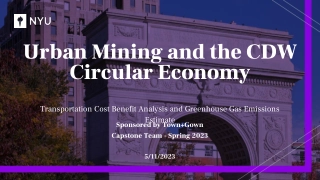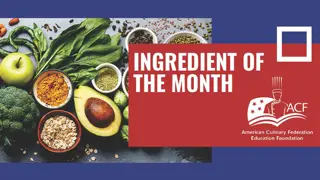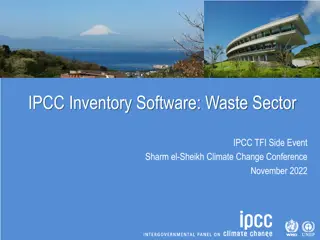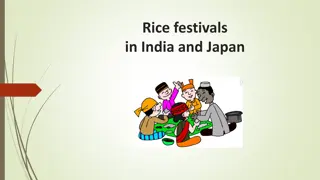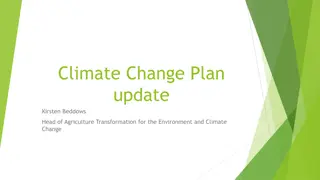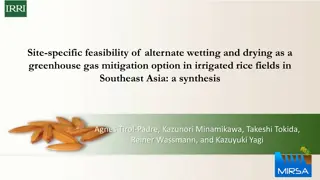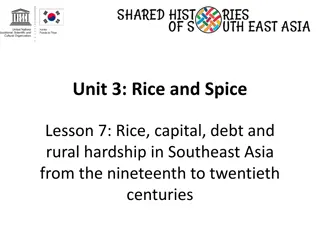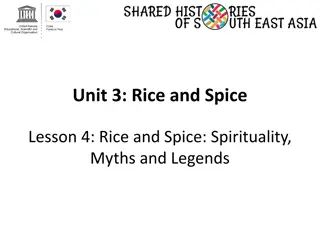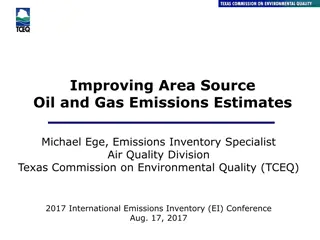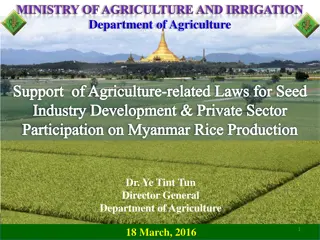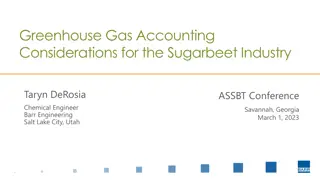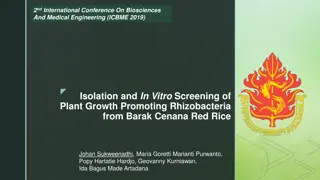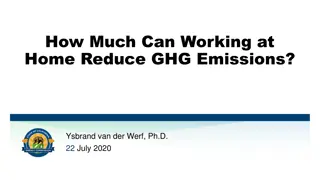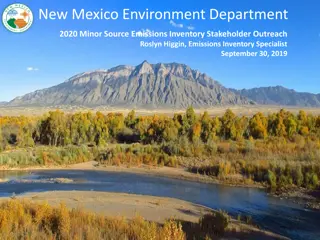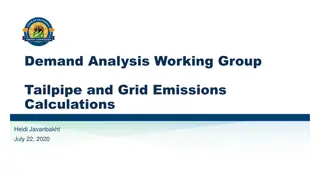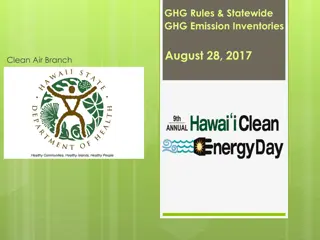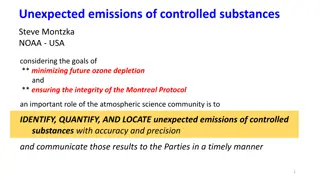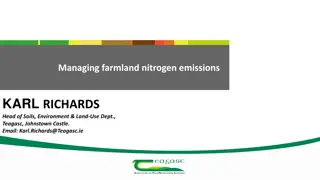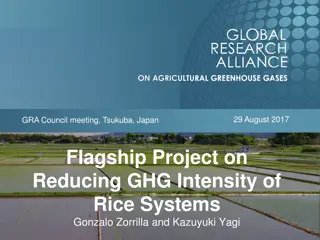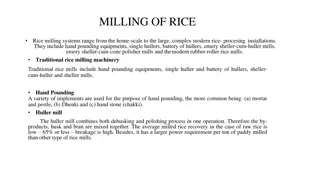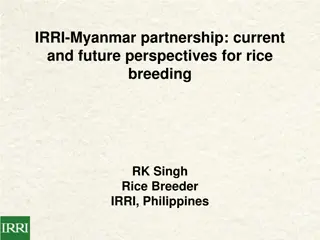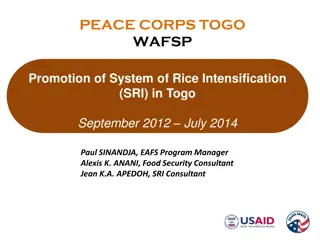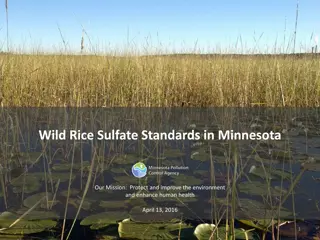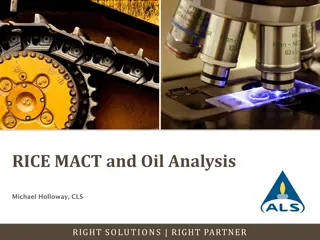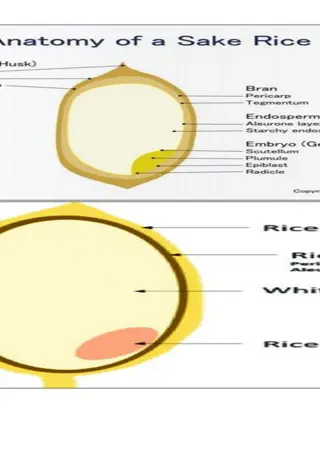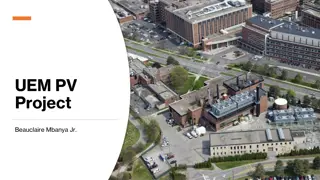A Corporate Accounting and Reporting Standard
This standard covers corporate accounting and reporting principles, tracking emissions over time, calculating emissions, and reporting GHG emissions.
2 views • 18 slides
A Corporate Accounting And Reporting Standard
Principles and guidelines for preparing GHG emissions inventories, focusing on organizational boundaries, operational boundaries, tracking emissions over time, calculating emissions, and reporting GHG emissions. It emphasizes relevance, completeness, consistency, transparency, and accuracy in accoun
1 views • 14 slides
A Corporate Accounting and Reporting Standard
This training curriculum covers principles of GHG accounting, organizational boundaries, setting operational boundaries, tracking emissions over time, calculating emissions, and reporting GHG emissions. It emphasizes the importance of determining which company operations and emissions sources to inc
2 views • 25 slides
Urban Mining and CDW Circular Economy Cost-Benefit Analysis
This case study focuses on comparing the cost and greenhouse gas emissions savings of local processing and reuse of Construction and Demolition Waste (CDW) materials versus sending them to landfills. By developing a prototype cost and GHG savings calculator, the aim is to showcase the potential of e
0 views • 14 slides
Sustainable Rice Production in Pakistan: Challenges and Strategies
Pakistan's economy heavily relies on rice exports, with the country being a significant producer and exporter. However, challenges such as pesticide residues, major insect pests, and diseases threaten rice production. Key parameters for production include cultivation of improved varieties, pest mana
2 views • 42 slides
Energy Transition and NRE Potential in Indonesia's Path to NZE 2060
Indonesia is focused on transitioning to Net Zero Emissions by 2060, with a significant emphasis on New Renewable Energy (NRE) sources. The country has made strides in increasing NRE utilization, with promising potential in hydro, solar, wind, geothermal, and ocean energy. Additionally, Indonesia is
1 views • 9 slides
Tradeoffs Between Water Savings and GHG Emissions in Irrigated Agriculture
This study examines the tradeoffs between water savings, economic impact, and greenhouse gas emissions resulting from technological changes in the irrigation industry. Key objectives include estimating water savings for different crops, quantifying GHG emissions from new irrigation technologies, and
0 views • 24 slides
Climate Action Strategy for Decarbonising Inland Transport by 2050
The Inland Transport Committee (ITC) has adopted a strategy to reduce greenhouse gas emissions from inland transport, aligning with the goal of achieving net-zero emissions by 2050. This strategy includes a focus on reducing GHG emissions, setting strategic objectives, implementing climate actions,
1 views • 19 slides
(❤Read⚡) Digital Rice Cooker Bliss: 150 Easy Recipes for Fast, Healthy, Fam
\"COPY LINK HERE: http:\/\/isbooktoday.com\/1945056231 |6 minutes ago - \n [PDF READ ONLINE] Digital Rice Cooker Bliss: 150 Easy Recipes for Fast, Healthy, Family-Friendly Meals | Your Rice Cooker CAN change your life. But are you using it correctly? Are you getting the most out of it? This bo
1 views • 6 slides
Understanding Consumption-Based Emissions Inventories in Boulder County
Consumption-Based Emissions Inventories (CBEIs) play a crucial role in assessing greenhouse gas emissions linked to local consumption patterns. By calculating emissions associated with products and services used by a community, CBEIs reveal significant gaps in traditional emissions tracking, emphasi
2 views • 13 slides
Challenges in the Rice Value Chain in Guinea
Guinea faces various challenges in its rice value chain despite being a significant producer. The country's production has increased, but it still struggles to meet domestic demand, leading to substantial rice imports. Rice cultivation is vital for Guinea's socio-economic development, with over 80%
6 views • 19 slides
The Fascinating World of Rice: History, Health Benefits, and Varieties
The history of rice spans cultures and millennia, with rice being a staple food for a significant portion of the world's population. It is grown in various regions worldwide, providing essential nutrients and energy. Whole grain rice offers numerous health benefits, such as being a rich source of ca
3 views • 20 slides
IPCC Inventory Software Enhancements for Waste Sector Emissions Estimation
Explore the latest enhancements in the IPCC inventory software related to waste sector emissions estimation. Major updates include subnational disaggregation, Tier 3 methods, wetlands supplement, and improvements in worksheet structure and layout. The software allows for detailed estimation of green
1 views • 10 slides
Vibrant Rice Festivals in India and Japan
Explore the cultural richness of rice festivals in India and Japan. From the Japanese Moon Festival to Makar Sankranti in India, experience the traditions, rituals, and delicious rice-based dishes that signify the importance of rice in these vibrant celebrations.
1 views • 6 slides
Transforming Agriculture for Climate Change: Kirsten Beddows' Vision
Kirsten Beddows, Head of Agriculture Transformation, shares an updated Climate Change Plan focused on reducing emissions, achieving net-zero by 2045, and creating sustainable farming practices. The plan includes over a hundred new policies targeting emissions reduction, land use optimization, and ca
0 views • 9 slides
Feasibility of Alternate Wetting and Drying as a GHG Mitigation Option in Rice Fields
This synthesis study explores the site-specific feasibility of alternate wetting and drying (AWD) as a greenhouse gas mitigation option in irrigated rice fields in Southeast Asia. The research analyzes the impact of environmental and soil properties on GHG mitigation, evaluates trade-offs and co-ben
1 views • 19 slides
Globalization and Economic Development in Southeast Asia's Rice Industry
Southeast Asia's rice industry played a crucial role in the region's globalization and economic development from the 19th to 20th centuries. Colonization, capitalism, and the rise of export industries led to significant changes in rural livelihoods, migration patterns, and trade relationships. Peasa
3 views • 17 slides
Rice and Spice: Exploring Spirituality, Myths, and Legends
Delve into the cultural significance of rice in Southeast Asia, where it serves as a staple food, symbol of wealth, and central element in various rites and rituals. Explore historical accounts of rice ceremonies and the spiritual beliefs tied to rice cultivation. Engage in discussions on the symbol
2 views • 8 slides
Emissions Reductions Beyond the Clean Smokestacks Act (CSA) Overview
Emissions Reductions Beyond the Clean Smokestacks Act (CSA) is a comprehensive program aimed at improving air quality by imposing limits on pollutant emissions from coal-burning facilities. The act has successfully achieved significant reductions in nitrogen oxide (NOx) and sulfur dioxide (SO2) emis
1 views • 12 slides
Enhancing Oil and Gas Emissions Estimates for Area Sources
This presentation by Michael Ege, an Emissions Inventory Specialist at the Texas Commission on Environmental Quality (TCEQ), focuses on improving area source oil and gas emissions estimates. It covers the methods used to estimate emissions, including the development of basin-specific equipment profi
0 views • 31 slides
Overview of Air Emissions and Quality Assessment in Shale Gas Development
The presentation discusses the estimation of air emissions from shale gas development and production in North Carolina, highlighting the importance of analyzing emissions from oil and gas activities and associated truck traffic. The process involves building emissions inventory, photochemical modeli
0 views • 22 slides
Greenhouse Gas Emissions Management in Warehouse Operations
The SQAS Assessor accreditation training in April 2022 focused on measuring and reducing greenhouse gas emissions in warehouse operations. The content covers emission questions, scope of emissions, energy consumption examples, disaggregation of emissions, emission intensity calculation, and strategi
0 views • 17 slides
Challenges and Opportunities in Myanmar Rice Production Industry
The demand for rice is on the rise globally, driven by population growth and changing consumption patterns. In Myanmar, various types of rice cultivation methods are practiced to meet the increasing demand. The country faces challenges in seed production and supply, with the need to bridge the gap b
3 views • 24 slides
Greenhouse Gas Accounting Considerations for Sugarbeet Industry
Explore the importance of greenhouse gas (GHG) inventories for the sugarbeet industry, including benefits, steps to develop inventories, and the significance of tracking GHG emissions. Learn about key gases impacting climate change and the role of GHG Protocol Organization Accounting Standards. Disc
0 views • 28 slides
Isolation and Screening of Plant Growth-Promoting Rhizobacteria from Barak Cenana Red Rice
This research focuses on isolating and screening plant growth-promoting rhizobacteria from Barak Cenana red rice, a local cultivar known for its high anthocyanin and vitamin B content. By studying the potential of these bacterial isolates as microbial inoculants, the aim is to improve the cultivatio
0 views • 20 slides
Potential Reduction of GHG Emissions by Working at Home
This analysis explores the impact of increased remote work on reducing greenhouse gas emissions, particularly in the context of the COVID-19 lockdown. By examining workforce data, commuting patterns, and emission statistics in California, the study aims to quantify the potential decrease in GHG emis
0 views • 15 slides
Understanding Emissions Inventory for Air Quality Management
Emissions inventory plays a crucial role in monitoring air pollutant discharges and assessing air quality. This article discusses the purpose of emissions inventory, distinguishing between actual and permitted emissions, and provides guidelines for preparing and reporting minor source emissions inve
0 views • 15 slides
Demand Analysis Working Group: Tailpipe and Grid Emissions Calculations Overview
This report discusses the methodology for calculating tailpipe emissions using vehicle stock and VMT data, along with grid emissions from charging PEVs. Challenges include differences in vehicle classifications and lack of trip forecast calculations. Mapping LDVs from CEC classes to EMFAC classes wa
0 views • 10 slides
Hawaii Statewide Greenhouse Gas Emission Rules Overview
The Hawaii Statewide Greenhouse Gas (GHG) Emission Rules implemented by Act 234 in 2007 aim to limit statewide GHG emissions to 1990 levels by 2020. The rules include setting emission caps for stationary sources, conducting annual evaluations to track progress, and reporting GHG inventories regularl
0 views • 9 slides
Monitoring Unexpected Emissions of Controlled Substances for Ozone Protection
The atmospheric science community plays a crucial role in identifying, quantifying, and communicating unexpected emissions of controlled substances to support the goals of minimizing future ozone depletion and upholding the Montreal Protocol. By comparing observation-based estimates of global emissi
0 views • 13 slides
Managing Farmland Nitrogen Emissions: Strategies and Research Updates
Soils play a crucial role in greenhouse gas emissions and carbon sequestration. Karl Richards, Head of Soils, Environment & Land-Use Department at Teagasc, discusses the importance of managing farmland nitrogen emissions through various practices. Research focuses on reducing emissions and enhancing
0 views • 8 slides
Flagship Project on Reducing GHG Intensity of Rice Systems
This project aims to find practical measures to reduce emission intensity of rice systems while improving production efficiency. Components include water and organic matter management, cultivar selection, and modeling. Projects focus on improving water management techniques in American and Asian ric
0 views • 6 slides
Overview of Rice Milling Systems and Modern Processes
Rice milling systems range from traditional hand-pounding equipment to modern, large-scale installations. Various types of mills are used for dehusking and polishing rice, with methods like battery of hullers and sheller-cum-huller mills. The modern rice milling process begins with cleaning to remov
0 views • 8 slides
Advancing Rice Breeding Partnerships in Myanmar: Current Progress and Future Prospects
The collaborative efforts between IRRI and Myanmar in rice breeding have been fruitful since 1965, with numerous rice varieties released in Myanmar having IRRI lineage. The focus is on developing appropriate rice varieties for different regions to ensure rice yield stability. Target traits for delta
1 views • 17 slides
Promoting System of Rice Intensification (SRI) in Togo to Enhance Food Security
This initiative led by Peace Corps Togo aims to address food security challenges in Togo by promoting the System of Rice Intensification (SRI) from September 2012 to July 2014. With a focus on enhancing the capacity of rice farmers and tackling constraints in rice production, the project targets imp
3 views • 17 slides
Protecting Wild Rice in Minnesota: Sulfate Standards and Environmental Preservation
Understanding the importance of safeguarding wild rice in Minnesota due to its cultural, spiritual, and economic significance along with its sensitivity to sulfate pollution. Exploring sources of sulfate, the sulfate-sulfide relationship, and proposed solutions for maintaining wild rice populations.
0 views • 10 slides
Rice GHG Emissions under Varied Nitrogen, Variety, and Water Management Study in Arkansas
Detailed study on rice greenhouse gas emissions under varied nitrogen, variety, and water management treatments, focusing on nitrogen fertility, crop varieties, and water usage impact on methane and nitrous oxide emissions. Research examines optimal nitrogen rates for reduced global warming potentia
1 views • 18 slides
Understanding RICE MACT and its Impact on Air Quality
The RICE MACT (Maximum Achievable Control Technology) regulation aims to reduce emissions of Hazardous Air Pollutants (HAPs) from reciprocating internal combustion engines. It applies to major industrial sources emitting significant amounts of HAPs and outlines emission requirements for different ty
0 views • 26 slides
Understanding the Anatomy of a Rice Grain
The anatomy of a rice grain consists of the hull, pericarp, testa, and bran layers, each serving a unique purpose in protecting the seed and providing essential nutrients. The hull, pericarp, and bran are successively removed during the milling process, impacting the nutritional content of the final
0 views • 12 slides
Renewable Energy Analysis & GHG Emissions Reduction in NY & Solar Rooftop Potential
Explore the analysis of renewable energy projects like UEM.PV Project Beauclaire Mbanya Jr. and New York State Energy Portfolio, alongside Solar Rooftop Potential and GHG Emissions Reduction initiatives. Discover insights on solar energy generation, system size, cost, efficiency, and rooftop space u
0 views • 13 slides



